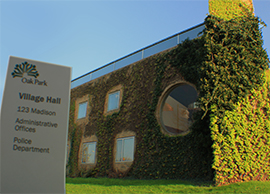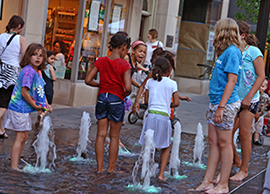July 31, 2015 - With headlines focusing on Chicago’s Divvy bike sharing program expanding into Oak Park, a less heralded portion of the same study on potential docking sites outlines how to transform the community into a mecca for bicyclists by linking neighborhoods via a network of routes that prioritize two-wheeled travel.
The study, conducted by the Active Transportation Alliance and recently approved by the Village Board, drilled into a broad, visionary bicycle plan created in 2008 to flesh out specific strategies for implementing two components of the original plan – a bike-sharing program and a bicycle boulevard system connecting a grid of low-traffic, low-speed routes on residential streets.
Neighborhood greenways, as the study calls the bicycling routes, use infrastructure features that calm and reduce vehicle traffic on neighborhood streets, and improve safety at busy intersections. The goal, the study says, is an attractive, safe and comfortable environment for bicyclists of all ages, and more peaceful residential streets.
The study recommends all or parts of 10 streets to be included in what eventually would be a 17-mile greenway network connecting bicyclists to schools, parks and businesses throughout the community.
Kenilworth and Home avenues, Scoville and Fair Oaks avenues, and Lombard and Harvey avenues are recommended for the north-south routes. Parts of Le Moyne Parkway, Thomas Street, Pleasant Street, Harvard Street, Van Buren Street, Adams Street and Harrison Street were recommended for the east-west routes.
Route features would include green painted lanes at intersections of high-volume streets to indicate to drivers where cyclists would be traveling. Other features would include greenway pavement markings throughout the network, dedicated bicycle left turn lanes, stop and yield signs, bicycle signal detectors and posted speed limits for motorists.
Implementing the greenway plan would be a long-term commitment, officials say, depending on the extent to which the wide range of recommendations in the study are adopted. Portions of the plan likely will be incorporated into the Village’s long-range capital improvement program, allowing for a phased-in implementation of the various recommendations as funds allow.
The Village of Oak Park has a long tradition of encouraging safe cycling with bicycle friendly share the road signs at all major community entry points, marked dedicated and shared bicycle lanes on numerous streets and bike racks located throughout the community.
For more information on bicycling in Oak Park and to read the 2008 Bicycle Plan and the new 2014 addendum, visit www.oak-park.us/bicycling.
* * *
Bike-sharing sites recommend
A study intended to help Oak Park implement a bike-sharing program recommended 13 potential locations for docking stations, as preparations continue for the expansion of Chicago’s Divvy program into the Village next spring.
The study by the Active Transportation Alliance recommends focusing on transit stations by placing the majority of the Divvy stations near Lake Street, the Eisenhower Expressway and Madison Street, with one station on Chicago Avenue.
Site recommendations are not final, officials say, as more public input will be gathered and additional analysis done before any final decisions are made.
A share of the funding for the Divvy expansion into Oak Park would come from a $3 million state grant, which also designated funds to expand the system into Evanston and Chicago's Austin and Rogers Park neighborhoods.
The Village’s share to implement the program will be about $160,000 or 20 percent of the total cost.
Each docking station typically houses a collection of bikes, along with an automated pay station that allows cyclists to rent out bikes at an hourly rate, 24 hours a day, seven days a week, year-round.
Details on how the recommended sites were selected is included in the study, which is posted at www.oak-park.us/bicycling.










